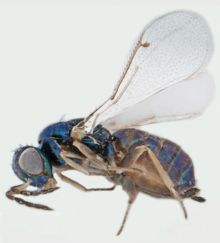Chalcidoid
| Chalcid wasp Temporal range: Cretaceous-Present |
|
|---|---|
 |
|
| Omphale cornula | |
| Scientific classification | |
| Kingdom: | Animalia |
| Clade: | Euarthropoda |
| Class: | Insecta |
| Order: | Hymenoptera |
| (unranked): | Proctotrupomorpha |
| Superfamily: | Chalcidoidea |
| Families | |
|
See text |
|
See text
Chalcid wasps (/ˈkælsɪd/, from Greek khalkos, meaning 'copper', for their metallic colour) are insects within the superfamily Chalcidoidea, part of the order Hymenoptera. The superfamily contains some 22,500 known species, and an estimated total diversity of more than 500,000 species, meaning the vast majority have yet to be discovered and described. The name "chalcid" is often confused with the name "chalcidid", though the latter refers strictly to one constituent family, the Chalcididae, rather than the superfamily as a whole; accordingly, most recent publications (e.g.,) use the name "chalcidoid" when referring to members of the superfamily.
Most of the species are parasitoids of other insects, attacking the egg or larval stage of their host, though many other life cycles are known. These hosts are to be found in at least 12 different insect orders including Lepidoptera (butterflies and moths), Diptera (true flies), Coleoptera (beetles), Hemiptera (true bugs), and other Hymenoptera, as well as two orders of Arachnida, and even one family of nematodes. For example, the chalcid fly is responsible for a small percentage of egg death in the wood white butterfly (L. sinapis). When the host is itself a parasitoid, they are referred to as hyperparasitoids. A small percentage are phytophagous and the larvae feed inside seeds, stems, and galls, including some that act as pollinators (e.g. fig wasps). Generally beneficial to humans as a group, chalcidoids help keep various crop pests under control, and many species have been imported as biocontrol agents. Moth parasitoid Copidosoma floridanum is one such species, whose genome is being sequenced by the Human Genome Sequencing Center as part of the i5K project, which aims to sequence the genomes of 5,000 arthropods.
...
Wikipedia
